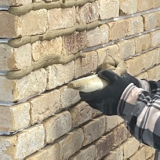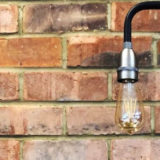Traditional brick pointing is something that we get asked a lot about here at Brick Slips. Whilst we offer a wonderful array of lime based technical pointing mortars sometimes our customers prefer to use more traditional materials.
Our brick slip products are effectively applied like tiles but the joints still need to be pointed up with mortar just like any other brick or masonry wall. The type of mortar you choose is entirely up to you and there are many factors to consider when it comes to pointing up your brick slip installation.
So let’s start with the basics.
What is Mortar?
In basic terms mortar is the material that separates one course of bricks from another. Traditionally cement or lime based, mortar is used with bricks, masonry and brick slips to create a solid, stable and weather proof joint which binds the individual units together.
The makeup of the most basic Traditional brick mortar is typically sand and cement.
Traditional Brick Pointing and Brick Slips
Traditional brick pointing methods are used in brick slip installations in exactly the same way as they would be for a brick built wall. A skilled tradesman will work the mortar into the joints by hand with a trowel and jointing tool. A relatively stiff and dry mortar mix is better for traditional brick pointing by hand as it is easier to work with.
While the professionals make it look easy it can take a bit of practice to achieve a uniform finish and keep the face of the brick clean.
There are many different types of joint finish to consider too, from the standard concave mortar joint to more specialist finishes like struck and raked joints.

For interior brick slip installations the choice of joint finish is mainly aesthetic but for exterior jobs it is obviously crucial that the joint is able to shed water.
Can I do it myself?
Absolutely! A brick slips installation is well within the capability of most DIY enthusiasts.
When it comes to traditional brick pointing methods, however, our advice would be to opt for our cement-free gun injection pointing mortar.
The gun makes it extremely easy to get to grips with pointing and with five colours available it works perfectly with our brick slips.

And although the product is specifically designed for gun injection it can be mixed stiff and pointed up by hand with traditional brick pointing methods if you prefer.
Conclusion
Although choosing your brick slips is the most fun and exciting part of planning your project, the type of mortar and joint finish you choose will really tie your brick slips installation together and determine how it works with your overall interior design scheme.
A darker mortar, for example, will emphasise the joint and make for a striking, bold statement while a lighter mortar can work well for a more natural look that compliments the colour and finish of the brick slips.
Whatever you choose our team is always on hand to offer help and advice at any stage of your project.
You can get in touch via our Contact Us page and we’d be happy to answer any questions you might have.
































